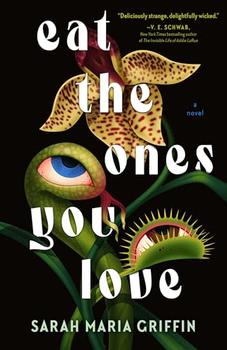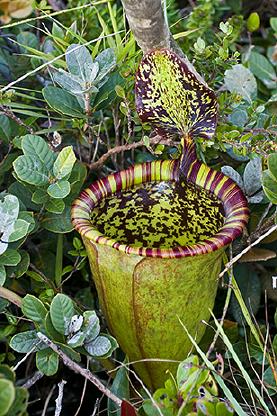Summary | Excerpt | Reviews | Beyond the Book | Read-Alikes | Genres & Themes | Author Bio

This article relates to Eat the Ones You Love
The main horror of Eat the Ones You Love comes from a ravenous orchid that can only be truly satisfied by human meat. It's a myth that some orchid species consume meat, but other carnivorous plants do exist. There are more than 600 known species that survive on insects and other animals; carnivory is such an efficient adaptation that it has evolved independently multiple times and occurs in unrelated plant families. Smaller carnivorous plants eat single-celled organisms, like bacteria, and aquatic plants also eat crustaceans, mosquito larvae, and small fish. Larger plants can eat reptiles and small mammals.
 Carnivorous plants use a variety of strategies to capture their prey. One of these strategies is pitfall traps: the plant has a single leaf or multiple leaves that form a pitcher shape, with nectar lining the pitcher's rim. The nectar attracts the prey to the rim, where a slippery substance causes it to fall into the base of the pitcher, which is filled with digestive fluid.
Carnivorous plants use a variety of strategies to capture their prey. One of these strategies is pitfall traps: the plant has a single leaf or multiple leaves that form a pitcher shape, with nectar lining the pitcher's rim. The nectar attracts the prey to the rim, where a slippery substance causes it to fall into the base of the pitcher, which is filled with digestive fluid.
Another mechanism used by some types of carnivorous plants is adhesive traps. Prey are attracted by sweet, sticky droplets that resemble nectar or dew drops. Upon contact, small insects are immediately trapped by the adhesive, while larger prey, when fighting to break free, end up getting ensnared in even more of the sticky slime. Victims are usually suffocated to death by the slime; some plants will also wrap their sticky tentacles around their prey. (One example of an adhesive trap plant is the sundew; horticulturist Peter D'Amato wrote that "If an insect ever evolved the brains to write a horror novel, the monster in that novel would probably be a sundew.")
The infamous Venus flytrap uses a type of trap called a snap trap: Attracted by flowers, the prey enters the plant's jaw-like leaf blades. The prey's presence triggers an electrophysiological impulse in the plant to snap the leaf blades closed; the prey gets trapped, and the plant secretes a digestive fluid around it. The Venus flytrap can grow large enough to trap small lizards. On the other hand, the waterwheel plant—the only snap trap plant that lives underwater—has traps only one centimeter long; they capture prey like mosquito larvae, small fish, and tadpoles.
More often, aquatic carnivorous plants use suction traps. The entrances of these traps are formed to look like the food or shelter of their prey. Once the prey is within reach, a valve door is triggered open, creating a suction that sucks the prey inside a hollow bladder. Then, the trapdoor closes and is sealed with slime.
Other plants use snare traps to capture single-celled organisms. Snare traps deceptively appear as innocuous—and delicious—roots, and lure prey with chemicals. The prey enters the snare trap through tiny slits and is pushed along by hairs on the plant into the digestive bladder. Still others, like the cobra lily, use light traps. Mesmerized by windows of light that tantalize with the false promise of escape, the cobra lily's prey ends up wandering deeper into the trap. It misses the true exit, which is hidden behind a dark, curved wall.
Image of Attenborough's pitcher plant courtesy of Dr. Alastair Robinson.
Filed under Nature and the Environment
![]() This article relates to Eat the Ones You Love.
It first ran in the April 23, 2025
issue of BookBrowse Recommends.
This article relates to Eat the Ones You Love.
It first ran in the April 23, 2025
issue of BookBrowse Recommends.
Your guide toexceptional books
BookBrowse seeks out and recommends the best in contemporary fiction and nonfiction—books that not only engage and entertain but also deepen our understanding of ourselves and the world around us.